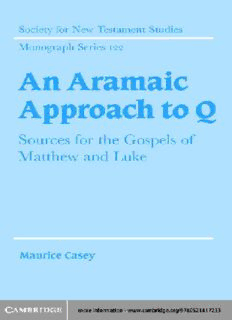
An Aramaic Approach to Q: Sources for the Gospels of Matthew and Luke (Society for New Testament Studies Monograph Series) PDF
Preview An Aramaic Approach to Q: Sources for the Gospels of Matthew and Luke (Society for New Testament Studies Monograph Series)
AN ARAMAIC APPROACH TO Q This is the first book to examine the Aramaic dimension of Q sincetheAramaicDeadSeascrollsmadesuchworkmorefeasible. MauriceCaseygivesadetailedexaminationofMatthew23.23–36 andLuke11.39–51anddemonstratesthattheevangelistsusedtwo differentGreektranslationsofanAramaicsource,whichcanbere- constructed.HeoverturnstheconventionalmodelofQasasingle Greekdocument,andshowsthatJesussaideverythingintheorig- inalAramaicsource.HisfurtheranalysisofMatthew11.2–19and Luke7.18–35showstheevangelistseditingoneGreektranslation ofanAramaicsource.ThesameistrueofMatthew12.22–32//Luke 11.14–23, for which Mark (3.20–31) utilised a different Aramaic source. A complex model of Q is thus proposed. Casey offers a compellingargumentthatAramaicsourcesbehindpartofQareof extremelyearlydate,andshouldmakeasignificantcontributionto thequestofthehistoricalJesus. MAURICE CASEY isProfessorofNewTestamentLanguagesand Literature at the Department of Theology of the University of Nottingham. He is a member of the Studiorum Novi Testamenti Societas and the author of Aramaic Sources of Mark’s Gospel (CambridgeUniversityPress,1998). SOCIETY FOR NEW TESTAMENT STUDIES MONOGRAPH SERIES GeneralEditor:RichardBauckham 122 AN ARAMAIC APPROACH TO Q An Aramaic Approach to Q SourcesfortheGospelsofMatthewandLuke MAURICE CASEY UniversityofNottingham Cambridge, New York, Melbourne, Madrid, Cape Town, Singapore, São Paulo Cambridge University Press The Edinburgh Building, Cambridge , United Kingdom Published in the United States of America by Cambridge University Press, New York www.cambridge.org Information on this title: www.cambridge.org/9780521817233 © Maurice Casey 2002 This book is in copyright. Subject to statutory exception and to the provision of relevant collective licensing agreements, no reproduction of any part may take place without the written permission of Cambridge University Press. First published in print format 2002 isbn--13 978-0-511-06115-8 eBook (NetLibrary) isbn--10 0-511-06115-3 eBook (NetLibrary) isbn--13 978-0-521-81723-3 hardback isbn--10 0-521-81723-4 hardback Cambridge University Press has no responsibility for the persistence or accuracy of s for external or third-party internet websites referred to in this book, and does not guarantee that any content on such websites is, or will remain, accurate or appropriate. CONTENTS Preface pageix Listofabbreviations x 1 Thestateofplay 1 2 Method 51 3 ScribesandPharisees:Matthew23.23–36// Luke11.39–51 64 4 JohntheBaptist:Matthew11.2–19//Luke7.18–35 105 5 Exorcismandoverlappingsources:Mark3.20–30; Matthew12.22–32;Luke11.14–23;12.10 146 6 Conclusions 185 Selectbibliography 191 Indexofpassagesdiscussed 206 Indexofnamesandsubjects 209 vii PREFACE Thisbookwaswrittenin1994–99.In1994–96,IheldaBritishAcademy ResearchReadershipawardedformetowriteAramaicSourcesofMark’s Gospel (SNTS.MS 102. Cambridge, 1998), as well as this book. The publicationoftherestoftheAramaicDeadSeascrollsin1994enabled more fruitful work to be done than I had planned, but at the same time it ruined the proposed timetable for completing the two books. I am extremelygratefultotheAcademyforthisaward,whichenabledmeto complete a major piece of research, including all the Aramaic for this book as well as the previous one. Other duties and engagements have contributedtothesubsequentdelay. Iamalsogratefultoallthosewhohavediscussedwithmetheproblems ofmethodandofdetailwhichthisworkhasentailed.Ieffectivelybegan this research while reading for a doctorate at Durham University under ProfessorC.K.Barrett,whoseextraordinarycombinationoflearningand helpfulnesswithlackofbureaucracyorinterferenceremainsamodelto which one can only aspire. I would particularly like to thank also the lateProfessorM.Black,ProfessorG.J.Brooke,ProfessorB.D.Chilton, ProfessorJ.A.Fitzmyer,ProfessorM.D.Goulder,ProfessorR.Kearns, the late Professor B. Lindars, Professor M. Mu¨ller, Professor C. M. Tuckett and Professor M. Wilcox. I would also like to thank members oftheAramaicBackgroundandHistoricalJesusseminarsatSNTS,the Jesus seminar at meetings of British New Testament scholars, and an annual seminar on the Use of the Old Testament in the New now gen- erally held at Hawarden, for what I have learnt from them. I alone am responsibleforwhatIhavesaid. IwouldalsoliketothankProfessorA.C.Thiselton,HeadoftheDepart- mentofTheologyattheUniversityofNottingham1992–2000,forhisim- partialandunfailingsupportofwork;myNottinghamcolleaguesDrR.H. BellandRabbiDrS.D.Kuninformanyhoursspentsortingoutproblems with the word processors on which these books were written; and the libraries of Durham University, St Andrews University, SOAS and the BritishLibraryforthefacilitiesnecessaryforadvancedscholarlywork. ix ABBREVIATIONS Most abbreviations are standard. Those for biblical books follow the recommendations of CUP; those for periodicals and series of mono- graphsfollowS.Schwertner,InternationalGlossaryofAbbreviationsfor TheologyandRelatedSubjects(BerlinandNewYork,1974);mostothers follow the recommendations for contributors to the Journal of Biblical Literature117(1998).Othersareasfollows: ABRL AnchorBibleReferenceLibrary ANRW H.TemporiniandW.Haase(eds.),AufstiegundNiedergang derro¨mischenWelt(manyvols.,Berlin,1972–). cur Curetonian DSD DeadSeaDiscoveries ET EnglishTranslation hark Harklean JSP JournalfortheStudyofthePseudepigrapha JSP.S Journal for the Study of the Pseudepigrapha Supplement Series MPIL MonographsofthePeshittaInstitute,Leiden palsyrlec PalestinianSyriacLectionary sin SinaiticSyriac x 1 THE STATE OF PLAY The present state of research into ‘Q’ varies from the chaotic to the bureaucratic.Atthechaoticendofthespectrum,thereisnoagreementas towhetherQexisted,norastowhatitwas,ifitdid.Atthebureaucraticend ofthespectrum,anamorphousgroupofscholarshaveagreedthatitwas aGreekdocument.ItwasproducedbyaQcommunity,whoseconcerns canbeworkedoutfromit.Someofthesescholarssupposethatwecan workoutwhatthisQcommunitydidnot believefromwhatwasnotin Q,tothepointthattheQcommunitydidnothaveanatonementtheology becauseQhasnopassionnarrative.Mostscholarswhobelievethisalso believe that Q was the first Gospel, and that its picture of Jesus was thatofsomekindofCynicphilosopher.Aswenarrowdownthegroupof scholarstomoredetailedagreements,soweseeanincreaseinthenumber ofcommonjudgementsmadeintheinterestsofaconsensusofthegroup, withquiteinadequateattentiontoevidenceorargument.Wealsoseethe large-scaleomissionofAramaic,thelanguageinwhichJesustaught. The purpose of this book is to suggest that the use of Aramaic has somethingtocontributetothestudyofQ.Inapreviousbook,Isuggested thattheGospelofMarkconsistspartlyofAramaicsourceswhichhave been literally translated into Greek. Consequently, they can be partly reconstructed. In the light of recent research, including that stemming fromthediscoveryoftheDeadSeascrolls,Isoughttolaydownthemost fruitfulwayofdoingthis,andIexemplifiedthiswithreconstructionsof Mark9.11–13,2.23–3.6,10.35–45and14.12–26.1Inthisbook,Ipropose to see what we can do for Q. After discussing the history of research, Iconsideragainthemostappropriatemethodologyforthiskindofwork. IthenreconstructanddiscussthesourcesofMatt.23.23–36//Luke11.39– 51andMatt.11.2–19//Luke7.18–35.Iturnfinallytooneofthe‘overlaps’ between Mark and Q, and discuss the recoverable Aramaic sources of Mark3.20–30,Matt.12.22–32,andLuke11.14–23;12.10.Throughout 1 P.M.Casey,AramaicSourcesofMark’sGospel(SNTS.MS102.Cambridge,1998). 1 2 AnAramaicApproachtoQ thesediscussions,IcontinuetheworkofmypreviousbookinthatIseek tocontributenotonlytoourunderstandingofQ,butalsototherecovery oftheJesusofhistory. Wemustbeginwithacriticalhistoryofscholarship.HereIdonotseek tocatalogueallpreviouswork,buttoselectfromthehistoryofscholarship significantadvancesandmistakes,sothatwecanseemoreclearlyhow toproceed,andwhatpitfallstoavoid.Oneofthepitfallsliesindifferent definitionsofwhatQwas,oris.Forclarity’ssake,Ithereforeanticipate oneoutcomeofthisbookbygivingthedefinitionwhichIusewhenIcon- ductmyowndiscussionofQ:Qisaconvenientlabelforthesourcesof passageswhicharefoundinboththeGospelofMatthewandtheGospel ofLuke,andwhichhavenotbeentakenfromMark’sGospel.Itwillbe clearthatthisentailssomecontroversialconclusions,andthatwemustbe carefultonotethatitdoesnotentailothers.ItimpliesthatQwasnotasin- gledocument,andthatLukedidnottakeallhisQmaterialfromMatthew; Ishallargueforbothofthesehypothesesindetail.Itmeansthatwecan meaningfullydiscusswhetherapassagesuchasMatt.11.28–30istobe describedaspartofQ;itisnotfoundinLuke,butwecoulddiscusswhether itwasinthesamedocumentarysourceasMatt.11.25–27//Luke10.21–2, whetherMatthewaddedit,whetherLukeknewitorwhetherLukeleftit out.ItalsomeansthatourevidenceforQisfoundinGreek;itdoesnot specifythatthisis,orisnot,howitreachedtheevangelists.Ishallargue thatsomepartsofQreachedbothevangelistsinthesameGreektransla- tion,andthatotherpartsareduetotwodifferenttranslationsbeingmade, whetherbytheevangelists,theirassistantsorbymoredistantsources. FromHoltzmanntoTo¨dt SeriousmodernresearchintoQeffectivelybeganwithHoltzmann,though this is not what he called it. In a book published in 1863, he suggested thattherewasonesourceAbehindtheTripleTraditionofthesynoptic Gospels, and a second major source behind the Double Tradition. This sourcehecalled(cid:1),whichstoodfor(cid:2)(cid:3)(cid:4)(cid:5)(cid:6).2 Atthisstage,however,the priority of Mark had still not been established, nor had anyone shown 2 H. J. Holtzmann, Die synoptischen Evangelien: Ihr Ursprung und geschichtlicher Charakter (Leipzig, 1863). For predecessors, cf. J. G. Eichhorn, ‘U¨ber die drey ersten Evangelien. Einige Beytra¨ge zu ihrer ku¨nftigen kritischen Behandlung’, in Allgemeine BibliothekderbiblischenLiteratur5(Leipzig,1794),pp.761–996;F.D.E.Schleiermacher, ‘U¨ber die Zeugnisse des Papias von unseren beiden ersten Evangelien’, Theologische StudienundKritiken5,1832,735–68;C.H.Weiße,DieevangelischeGeschichtekritisch undphilosophischbearbeitet(2vols.,Leipzig,1838),vol.I,ch.1,esp.pp.83–6.
Description: